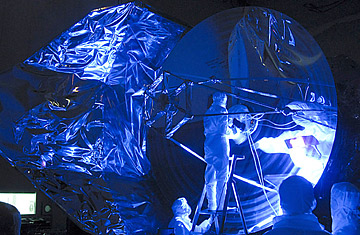
Herschel's 3.5-m diameter mirror is checked with ultraviolet light at Europeís Spaceport in Kourou, French Guiana
There is no shortage of ambition packed into the rocket that lifted off from French Guiana at lunchtime on Thursday. The celestial mission carries two space telescopes that aim to unravel the universe's biggest mysteries: the life and death of stars.
The European Space Agency's (ESA) twin telescopes, named Herschel and Planck, are being carried on an Ariane 5 launcher to take up a vantage point 930,000 miles (1.5 million km) from Earth. From there, they will gaze across the farthest corners of the cosmos to try to learn about the physics and chemistry behind the Big Bang. (See pictures of the Hubble telescope's achievements.)
The telescopes are expected to peer deeper into space and time than any telescope has done before. Their launch comes three days after NASA's space shuttle launch to repair the Hubble telescope, which, since its launch in 1990, has been regarded as the most important instrument in the study of the cosmos. However, the ESA says that Herschel and Planck will explore the science of space in a way that Hubble never could.
With its 11.5-ft.-wide (3.5 m) mirror, Herschel will be the biggest telescope in space. Named after the great 18th century British astronomer William Herschel, it will search a vast array of galaxies collecting radiation that emits from protostars, the dust clouds that contract to form stars and galaxies. Unlike Hubble, which is tuned to visible light, Herschel will go after much longer wavelength radiation in the far-infrared and sub-millimeter range. By allowing astronomers to study objects in space not visible in other wavelengths, it should record the formation of protostars for the first time.
The Planck telescope, named after the German physicist Max Planck, aims to reveal more about how the universe was formed nearly 14 billion years ago by mapping "fossil light." This relic radiation of the Big Bang — part of the Cosmic Microwave Background — should tell astronomers more about how the large-scale structures of the universe formed and evolved.
Planck will also attempt an extraordinary mathematical feat: calculating the total number of atoms in the universe. With that information, it can infer the total density of the mysterious quantity known as dark matter. "We're looking at the physics at the very beginning of the physical universe," says ESA director of science David Southwood.
Beyond their scientific missions, the telescopes represent major technological achievements. The primary detectors of the scientific instruments on both telescopes have to be kept as cold as possible to be able to obtain high-resolution data while they make their observations. If the instruments or their surroundings reach higher temperatures, then they start to emit infrared themselves, swamping faint emissions from cool celestial objects. That means operating at temperatures of minus 272.7 degrees Celsius (522.9 degrees Fahrenheit), just 0.3 degrees above absolute zero. To do that, they use a cryostat, a giant bottle filled with more than 528 gallons (2,000 L) of liquid helium, which evaporates at a constant rate and makes the instruments as sensitive as possible. (Watch TIME's video "The Final Shuttle to Hubble.")
The point of the telescopes, which cost a combined $2.5 billion, might seem abstract to a public that associates space missions with moon walks and Star Trek. But that misses the bigger picture, according to Colin Pillinger, who led the 2003 Beagle 2 project to land a spacecraft on the surface of Mars. "People always say these big questions don't have anything to do with their day-to-day life," he says. "But we get all sorts of spin-offs from asking about the universe. The technologies generated include carbon fibers, new electronic systems and sophisticated radio technologies. And perhaps more than that, they offer dreams for young scientists. They provide the inspiration for a new generation of pioneers."
It will be two months before Planck and Herschel reach their final destination, a gravitational "sweet spot" known as the Lagrange Point 2, where they can stay fixed in the same location relative to the earth and sun. Once there, they will need trillions of samples and bits of raw data before they can start generating their sky maps. But even if they deliver a fraction of the results that the eggheads on Earth are promising, the pictures should still be out of this world.
